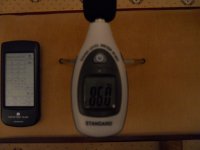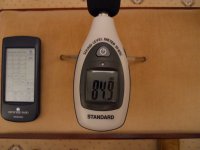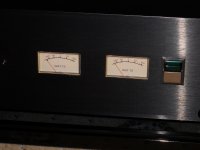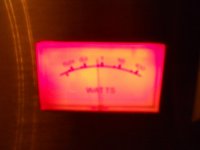Well as to the number of pages it depends on your forum settings, this one only reaches 8 pages for me 
The original poster was Pano though, he created this thread and it's his test and it is valid^>^
You can though. What is it you think you can't do?
The original poster was Pano though, he created this thread and it's his test and it is valid^>^
Oh hang on.....I thought this thread about a simple test everyone with a VM could carry out.
You can though. What is it you think you can't do?
Hard to say GM, the test isn't designed that way. Please see 5th Element's post above.What do you calculate doing it your way and what formula did you use to calculate the theoretical voltage level at 85 dB?
Basically you are doing this.
- Set your maximum volume
- Play a test tone and measure its voltage
- Calculate from the tone your maximum voltage level
Now, if for some reason you want to set pink noise at 85dB, I could supply a signal - if you supply the SPL meter. But how do I know where to set the level of the pink noise? At -12dB? -24dB? Somewhere else? My guess would be about -14dB as this is a common mastering level for the loud parts of well recorded music. But it's not universal.
So why not set the level with music at the loudest point you are comfortable with - which you say is 85dB (similar to a lot of folks) - and then do the test. If you have really set the volume to as loud as you like it on a good choice of several dynamic tracks, you will probably be close to 85dB. It doesn't matter if you aren't exactly at 85dB because you are at the loudest setting you like, by ear. That's how you determined 85 dB anyway, right? You measured music that you found by ear to be as loud as you like.
You can though. What is it you think you can't do?
Oh no, I can do the test and will shortly with 12LTA's and maybe some Minimus 7's and I have a pair of kef uni-q's about the place somewhere.
The test is easy and valid - 2 points apparently lost on some
BTW is it 4am where you are? Me? I'm 45hrs without sleep and counting... snow is pretty though
Naaawww.... Just look at the poll results.Any earnest mind has to battle through 30 odd pages of turd for a just a handful of measurement posts.
As I predicted, things went well when it was about voltage. When I brought power into it, things went pear shaped. There are so many preconceived ideas about audio power that it was bound to get messy. No big deal. All I really want is for people to get an idea of what voltages they are actually using, and how that might compare to others. I really don't give a damn how much power anyone uses.
Just as a note, this measurement grew out of my trying to figure out how much voltage I needed to run my Altec horns with an active crossover. Could I use a single tube gain stage - say an EL84 in SEP mode, and get enough voltage out to drive the horns? Answer - yes (just). Can I drive the woofers loud enough with it? Answer - No. Power was not my worry, I know that an EL84 has enough for the horns. I was just interested in getting enough voltage.
Once you know the voltage you need, then you can figure out other things if they are important to you, things like power and amperage.
Oh no, I can do the test and will shortly with 12LTA's and maybe some Minimus 7's and I have a pair of kef uni-q's about the place somewhere.
I look forwards to seeing the results
BTW is it 4am where you are? Me? I'm 45hrs without sleep and counting... snow is pretty though
Well 5am now
Naaawww.... Just look at the poll results.
Just as a note, this measurement grew out of my trying to figure out how much voltage I needed to run my Altec horns with an active crossover.
It's funny how we both started doing this for similar reasons with similar systems
its just a shame - your test is so simple and instead of being some hypothetical/standardised/extrapolated numbers its relevant to MY speakers in MY room with MY equipment MY music and most importantly MY ears!!!
Naysayers be damned - how much more relevant could it be?
Yes exactly and this is why this thread interests me so much too. People often quote SPL figures that your system should be able to reproduce and then often quote the ridiculous amounts of power you will need to get there. Most people though it seems simply don't listen as loud as these figures claim, or at least don't listen to music that actually requires the system to hit 105dB peaks with an average listening level of around 85dB.
with all due respect, it's you who doesn't understand that it's basically what you're saying only put another way.I've said nothing of the sort! Please don't put words in my mouth!
yes it will be unrelated. Pano's way will give exactly this:Regardless, it shouldn't be unrelated! That's the point!GM
Vout(cd) * gain
where:
Vout(cd) = the maximum voltage your CD player outputs
gain = your amp's gain (including the division factor caused by the position of the volume pot that gave your required SPL)
if the signal peaks are at 0dBfs you'll get exactly 12.6V (20W into 8 ohms). if they are below you'll get a larger number. different numbers. this is basic arithmetics. you are introducing unknown independent variables in the equation.
I wonder why no-one thought about it before. this is very informative. my levels are well within the majority as of today.Yes exactly and this is why this thread interests me so much too.
the reason why I hang out so much here is that I did the exact same test a while back and TBH the result (20-30W) surprised me. but fortunately I know since then that I don't need a kilowatt amp.
old wives tales and cockeyed theories as fact... where did I hear that before? oh and a lot of marketing I would add.People often quote SPL figures that your system should be able to reproduce and then often quote the ridiculous amounts of power you will need to get there.
the only objection to Pano's way I have is that it doesn't account for one thing: recording headroom. if a recording has a large headroom (like many but NOT ALL audiophile recordings) the resultant power will be actually larger.
Well it's supposed to take that into account, it's just a little hard to police. Since I don't have any good music demo tracks that I can legally upload here, we have to let the end users pick from their own music library. Hopefully folks will take the time to pick some dynamic tracks and figure out their highest volume setting.the only objection to Pano's way I have is that it doesn't account for one thing: recording headroom. if a recording has a large headroom (like many but NOT ALL audiophile recordings) the resultant power will be actually larger.
For those of you who like to work to a set standard, SMPTE and the EBU these days agree on 85dB, C weighted, slow for Pink noise recorded at -18dBFS RMS. You could playback a -18dB pink noise, set your volume control so that you measure 85dB and call it good. If you want to know what the peak voltage is at that calibrated level, you could then play back a test tone (mine, or some other) and measure it. Same results as my test, but you have set your level to a SMPTE/EBU standard via an SPL meter instead of by ear.
The big problem with that is that there is no CD mastering standard. They don't follow SMPTE guidelines. And I can guarantee you that -18dB pink = 85dB at your chair is going to be LOUD on most CDs in domestic settings. Try it, if you don't believe me.
Not a mistake...............I will freely admit that I should have been more clear about using dynamic recordings in the first posts. My mistake. I will go back and edit that so as to be more clear...........
Simply that the test as proposed is flawed.
It does not predict how little power we need to avoid clipping when we play our systems at the loudest we want to hear at.
Andrew, this is so completely wrong that I'm surprised at you.Simply that the test as proposed is flawed.
It does not predict how little power we need to avoid clipping when we play our systems at the loudest we want to hear at.
What don't you understand about the test? All your concerns have been met and explained by me and by others.
Until you can demonstrate, point by point, how the test is flawed, I must consider your responses irreverent.
For those of you who own an SPL meter - or want to buy one - here is some pink noise for you. It is recorded at -18dBFS RMS. There are two files. One is mono, the other stereo. In the stereo file, left and right are uncorrelated, I.E. they are random compared to each other. Each is 11 seconds long.
I suggest playing them in loop, one after the other. Move your SPL meter around the listening area and look for an average 85dB reading. Your meter should be set to Slow and C weighting.
This will set your system to the SMPTE PR-200 standard level. The EBU uses the same level. Movie soundtracks are supposed to be mastered at this level. This should give you 18dB of headroom over the average level. or peaks of 103dB, if your amp and speakers can do it.
I think you will find that this is much too loud for normal CD listening, as many CDs are mastered much hotter than this. The peaks won't be higher, they are still at 0dB on the recording, or 103dB SPL at your chair. It's the average level of most CDs that will be higher. But that's OK, it may be close to your "As Loud as I Ever Want to Go" setting found by ear. I doubt you'll ever run louder than this, but please tell us if you do.
I suggest playing them in loop, one after the other. Move your SPL meter around the listening area and look for an average 85dB reading. Your meter should be set to Slow and C weighting.
This will set your system to the SMPTE PR-200 standard level. The EBU uses the same level. Movie soundtracks are supposed to be mastered at this level. This should give you 18dB of headroom over the average level. or peaks of 103dB, if your amp and speakers can do it.
I think you will find that this is much too loud for normal CD listening, as many CDs are mastered much hotter than this. The peaks won't be higher, they are still at 0dB on the recording, or 103dB SPL at your chair. It's the average level of most CDs that will be higher. But that's OK, it may be close to your "As Loud as I Ever Want to Go" setting found by ear. I doubt you'll ever run louder than this, but please tell us if you do.
Attachments
FWIW, I just tried the above test of setting my system level at 85dB. It came up right at 12:00 on the volume knob. Surprise, surprise. 12:00 was my by ear "plenty loud enough" setting.
I do find it much too loud for most listening. Checking at an enjoyable listening level I find the input signal is 8-12dB lower on average.
I do find it much too loud for most listening. Checking at an enjoyable listening level I find the input signal is 8-12dB lower on average.
Thanks for your response GM this is actually a very good example of what this test isn't about and can hopefully serve as a good example for those who perhaps don't quite get it.........
You're welcome! Thanks for the thread summary, I don’t have time these days to do more than a quick scan of long threads.
The test does seem a reasonable alternative to the time honored SPL measurement way to determine a 70V distributed system’s power requirements in today’s digital ‘world’, but it's what it claims to do that concerns me, i.e. provide the information required for someone to determine how much power they need ‘worst case’ if they don't want to clip the amp with whatever digital sources they currently have on hand [or may buy in the future, not to mention some analog recordings] plus I see no way to use it for setting up a proper HT and/or multi-channel music system, so don’t want folks to be mislead into believing this procedure will necessarily do what is being claimed.
I mean how does one know how much their existing amp and/or speakers is probably clipping doing this test unless it’s already sufficiently oversized, especially if it’s a tube amp and/or ‘FR’ driver? Or how dynamic the signal?
Folks tend to set max levels based on audible distortion, so any conclusion seems predicated on a test that may be ill suited for the app since the more dynamic it is, the more it’s likely to be clipped, so it may be just less clipped with the calculated power available unless the normal average is somewhat, to well, below the test setting.
Worse, the most dynamic CDs I have don’t have the most power hungry spikes in its loudest passages, so how is some arbitrarily chosen 120 or 220 Hz test tone going to account for these spikes?
Indeed, the only way I can [or at least once, could] hear them was by noticing more top end ‘air’ around the instruments after seeing the spikes using an SLM, i.e. one step closer to what I’ve experienced in concert halls, piano bars, etc., so how likely is one to notice such subtlety using this test unless their amp, speaker system was already grossly oversized [at least by the tone of this thread] and know what to listen for?
105 dB peak/channel at the Lp is a goal for those folks that want to reproduce movie soundtracks at DD/THX/DTS reference. This is based on an 85 dB average at the LP. Since the gain is fixed at 20 dB for the mains and 30 dB for the LFE channel, it’s scaleable to whatever average or peak one desires.
If not sitting up close, it also happens to be in the ballpark for the piano bars, jazz clubs, small concert venues or similar I once frequented before mind numbing ‘loud’ at the expense of SQ became a prerequisite, so has been my personal reference level for long before these standards were proposed, though of course the dynamics of live venues are somewhat higher than all but a precious few recordings I’ve owned/auditioned.
Not that I haven’t enjoyed some of the loudest concerts on record to the point of ~mimicking them at home with the required highly efficient, high powered sound system required that might not have been adequate based on my understanding of this test if done today. As TD noted:
“How much Voltage does it take to reproduce the variety of things I like to listen to in their dynamic entirety?
The answer to me seems that it depends on the dynamic peak to average ratio in the music and the dynamic nonlinearity of the speakers and not just 4X the .5VRms margin.
That margin IS plenty for a lot of recordings, especially modern pop but well short of others, way short of reproducing real life events in a normal noise floor.”
All that said, if it’s a high output impedance tube amp, I’m ambivalent about clipping the really fast transients as the amp’s harmonic distortion is normally perceived as adding top end ‘air’ regardless, so this test should be adequate for finding its reasonably low distortion power minimum or conversely, the speaker’s efficiency to meet a specific average SPL.
GM
Sorry GM, you simply don't understand the test. All the issues you mention above have been covered. I've tried to explain it, but it seems to be out of my reach to do so.
It's super simple and easy to do.
The ONLY variable is where you set your volume control. I've asked for folks to do that using dynamic recordings and have now even supplied pink noise for an 85dB reference.
I just don't know how much simpler I can make it.
I'll go over your points 1 by 1 in a few minutes.
It's super simple and easy to do.
The ONLY variable is where you set your volume control. I've asked for folks to do that using dynamic recordings and have now even supplied pink noise for an 85dB reference.
I just don't know how much simpler I can make it.
I'll go over your points 1 by 1 in a few minutes.
Test is done, apologies for the rotten pics... it was so bleedin' loud ya know 
And that's with a fresh set of earplugs well fitted lol
So I did the test, you can see the SPL meter here, C weighted. Very little difference between the mono and stereo tracks.
I then went back and ran Panos 220 Hz track at this same volume setting and measured 3.7 volts RMS.
Keeping that volume setting I played the Eroica track that I posted "Cooledit" shots of earlier. That peaked at around 93 ish db. And it was to loud for comfortable listening for me at that.
The Mooly Amp has power meters accurately calibrated in volts onto 8 ohms and so I guestimate the Pano noise test at 0.5 w RMS. Clear shot of the meters so you can see the scale.
And that's with a fresh set of earplugs well fitted lol
So I did the test, you can see the SPL meter here, C weighted. Very little difference between the mono and stereo tracks.
I then went back and ran Panos 220 Hz track at this same volume setting and measured 3.7 volts RMS.
Keeping that volume setting I played the Eroica track that I posted "Cooledit" shots of earlier. That peaked at around 93 ish db. And it was to loud for comfortable listening for me at that.
The Mooly Amp has power meters accurately calibrated in volts onto 8 ohms and so I guestimate the Pano noise test at 0.5 w RMS. Clear shot of the meters so you can see the scale.
Attachments
- Home
- Loudspeakers
- Multi-Way
- A Test. How much Voltage (power) do your speakers need?
 Several off topic and personal posts have been deleted. Please let's focus on the discussion and not each other.. Thanks..
Several off topic and personal posts have been deleted. Please let's focus on the discussion and not each other.. Thanks.. 


